 |
Organic Society
Oligarchies in Modern Democracies
Plinio Corrêa de Oliveira
Since 1789, the year that marks the French Revolution, State influence in revolutionary governments has increased, causing more and more individuals to fall under the dominion of a State that does everything. It even started to control cultural activities such as music, theater, art and cuisine under the pretext of subsidizing worthy projects. Since the State has seemingly endless financial resources, it can offer financial assistance easier than anyone else. For example, it can promote a certain school of painting in a way that puts other similar artists out of the competition. The same happens with many other fields of activity.
In this way, the State has increasingly taken on the role of a maestro of an orchestra where each person is nothing more than a simple musician performing what he is commanded to play. That is to say, there is a veiled dictatorship of the State under the appearance of democracy. The heads of the State are elected in supposedly free and secret elections. Based on these suppositions, it is affirmed that those who are elected are truly the representatives of the people, and that it is the people who are in charge. This is the foundation of democracy: the people are sovereign.
I believe that this thesis is not accurate.
Who has the ear of the sovereign-people?
Let me suppose that the elections really are representative of the people - a thesis open to discussion. In this case, the elected officials would truly represent the people, and the people would be the king, the sovereign.
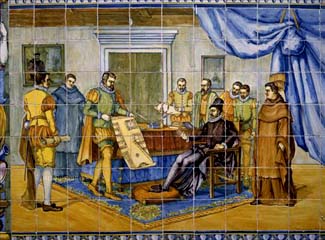
King Philip II receives the counsel of the Royal Architects |
In a monarchy, the power was exercised not only by the king, but also by those who “had the ear” of the king, as it was the custom to say. These were the ones whom the king would consult before making a decision. They gave him reports, new information, advice, etc. Therefore, it was through them that the king saw, heard and spoke. Thus it was said that they were the eyes, ears and mouth of the king. Now, how does this apply to the sovereign-people?
Who has the ear of this king? It is the media. I think it is perfectly ridiculous to say that all citizens have a vote of equal value when the owner of a great newspaper puts out more than one million copies a day, and other citizens are simple individuals. Actually, the ear of the sovereign-people is in the hands of the owners of newspapers, television and radio stations, and other means of social communications. A man who publishes an article that is read by one million readers obviously has enormously more influence than a person with a circle of ten friends or family members whom he influences. To say that this simple man equally decides about the future of his country as the owner of a great newspaper or a chain of television stations is a joke.
The true aristocrats - better said, oligarchs, since oligarchy is the corruption and the caricature of aristocracy - are the owners of these means of social communication.
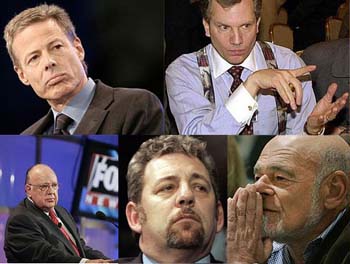
Behind the modern media moguls are the banks and the Revolution |
However, given that the newspapers, television and radio rely in great measure on the banks, we see that in point of fact the bankers are the ones who direct the people. Large newspapers, even the best organized, need the backing of a bank to operate. Otherwise, a crisis caused by salary increases or unexpected higher costs of paper, machinery, electronic gadgets, etc. can bring the company to the brink of bankruptcy. Therefore, the bankers actually have the last word on what will or will not be told to the sovereign-people.
This being the case, we see that in reality democracy does not exist. We live in an oligarchy dominated by money and those who command the money. This is the reality.
Those who control public opinion can orient it this way or that at their own discretion, like a driver with his car. The automobile driver needs to know the basic traffic rules to avoid accidents; so also do those leaders of public opinion. They need to avoid accidents on the road they decide to take, and that is all. Yes, the media owners control the people at their discretion, but if they do not follow the lines of the Revolution, the bankers will not lend them money when they need it. Therefore, ultimately it is the Revolution that controls public opinion.
What the Revolution aims to do is gradually change the mentality of a people, making it pass from one way of seeing things to another completely different way.
The artificial imposition of modern art
Let me give you an example in the field of art. How did modern art come to be accepted, and even admired?
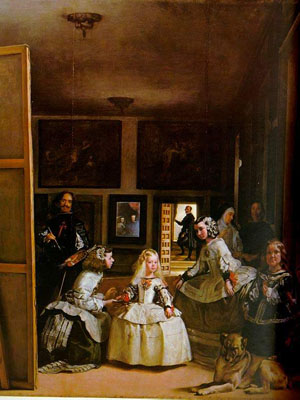
In his Las Meninas, Velasquez presents
the noble ambience of a Madrid royal palace |
You can take two pictures with the same name painted by two different Spanish artists: Las Meninas [The Girls] (1656) by Velasquez and Las Meninas by Picasso (1957).
When we analyze Velasquez’ work, we admire his effort to portray reality as it was, viewed under a favorable light. Las Meninas shows a large room in the Madrid palace of King Philip IV of Spain, and presents the young Infanta Margarita surrounded by her maids of honor and chaperone, a bodyguard, and two dwarfs and a dog. Behind them, Velázquez portrays himself wearing the red cross of the Order of Santiago and working at a large canvas.
You see that the art in the Velasquez picture reflects reality through a noble prism. The painting constitutes an effort to objectively perpetuate the memory of the noble princess and her entourage as well as to leave a dignified picture of himself for history.
There is a general concern for proportion, order, beauty and refinement. This picture legitimately attracts our attention as an agreeable document of that epoch and piques our curiosity to know who those personages were.
Now, look at the work of Picasso. He had no other goal but to disfigure the piece of Velasquez. He took that same picture of the Spanish master and distorted it as much as he could. His action was that of a revolted man who hates the order in his old family home, so he enters it and destroys it as much as he can.
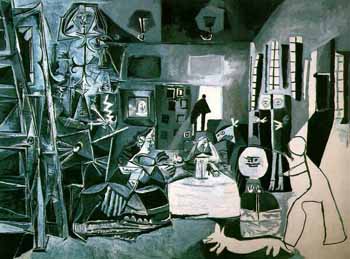
Picasso distorts Velasquez' work as much as he can |
Picasso’s picture is the proper expression of the communist that he was. As a communist, he wanted to see every single aspect of the old order distorted, if not completely annihilated.
Even if one is unaware that one picture is a distortion of another, how is possible for a normal man to have any admiration for Picasso’s painting? The figures are misshapen or broken; they look more like monsters than human beings. There is nothing culturally redeeming in the work that can offer formation to the mind of an uninformed viewer. A person who sees it has the impression that it was conceived by a mentally ill person. I believe that there is no art in this work.
Now, how did it happen that Picasso became a kingpin of modern art, one of the most popular contemporary artists? I really don’t believe that this occurred because his art is attractive - it would be so only for a small group of revolted communists, but not for the great public.
I think that Picasso became famous because of the promotion of the Revolution, which wants to accustom people to the horrendous. We saw decades of constant media propaganda promoting his paintings. We witnessed his works being bought in international auctions by banks and museums around the world for exorbitant prices. The result is that today Picasso’s caricature of Las Meninas has an equal or perhaps greater fame than Velasquez’ masterpiece.
When I consider these two paintings, it comes to my mind that the choice between Velasquez and Picasso in some way repeats the choice between Our Lord Jesus Christ and Barabbas. Behind the choice for Picasso is an artificial promotion made by the oligarchs of our times, just as behind the choice for Barabbas were the promoters of the evil of that time.

Posted February 23, 2009

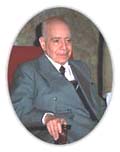  | | Prof. Plinio |
Organic Society was a theme dear to the late Prof. Plinio Corrêa de Oliveira. He addressed this topic on countless occasions during his life - at times in lectures for the formation of his disciples, at times in meetings with friends who gathered to study the social aspects and history of Christendom, at times just in passing.
Atila S. Guimarães selected excerpts of these lectures and conversations from the trancripts of tapes and his own personal notes. He translated and adapted them into articles for the TIA website. In these texts fidelity to the original ideas and words is kept as much as possible.

Related Topics of Interest
 Restoring a Closed Economy Restoring a Closed Economy
 'Jesus 2000' - A New Model Ideal 'Jesus 2000' - A New Model Ideal
 Opposed Poles of Society: Prestige and Money Opposed Poles of Society: Prestige and Money
 Proportion between the City and the Man Proportion between the City and the Man
 Critique of Capitalism from an Organic Perspective - Part I Critique of Capitalism from an Organic Perspective - Part I
 The Harmful Mentality of Borrowing Money - Part II The Harmful Mentality of Borrowing Money - Part II
 Vocations of the European Peoples Vocations of the European Peoples

Related Works of Interest
|
|
Organic Society | Social-Political | Home | Books | CDs | Search | Contact Us | Donate

© 2002-
Tradition in Action, Inc. All Rights Reserved
|
 |
|